Variation: CinnaYums Tutorial
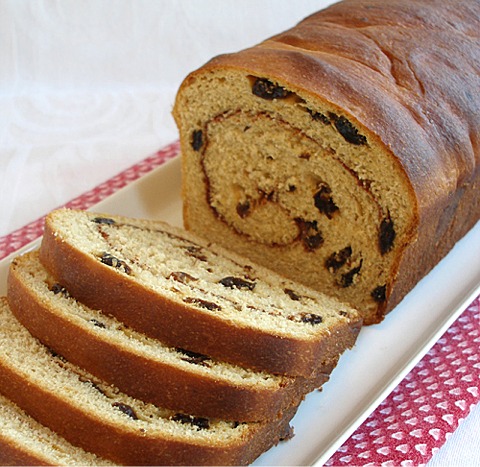
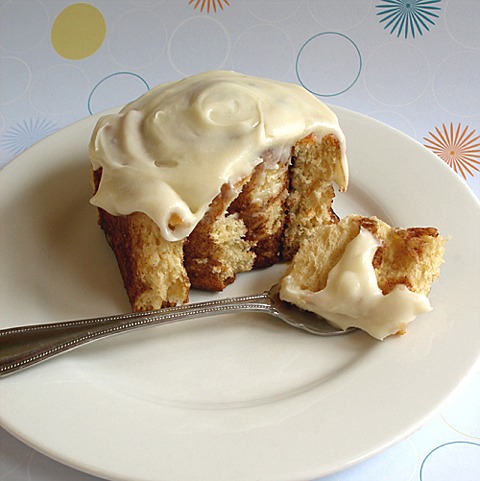
This has been my go-to cinnamon swirl raisin bread recipe for eons.
It is slightly sweet, delightfully spicy and it makes great toast too. French toast made from this bread is truly drool-worthy!
A few changes and you can create cinnamon buns from the same dough, which I call CinnaYums.
BREAD RECIPE HELP
INGREDIENTS
Bread:
1 cup whole or 2% milk, heated in microwave to 100 degrees F; divided
2 teaspoons sugar
2 1/2 teaspoons active dry yeast
1/2 cup sugar
1/3 cup unsalted butter, melted and cooled to lukewarm
2 large eggs
1 teaspoon vanilla extract
1 teaspoon salt
4 1/2 to 5 cups unbleached all purpose flour, sifted; spoon into measuring cup and level to rim and, then sift
1 cup raisins
Cinnamon filling:
2 tablespoons sugar
1 1/2 tablespoons cinnamon
2 tablespoons unsalted butter, melted and cooled to lukewarm
For brushing loaves before baking:
2 tablespoons unsalted butter. melted and cooled to lukewarm
INSTRUCTIONS
STEP I: MIX THE BREAD DOUGH
Proof the yeast: to activate it for use in the recipe.
1. Place 1/4 cup of the warm milk in a small bowl. Stir in 2 teaspoons sugar.
Sprinkle the yeast over the surface of the milk / sugar mixture. Let sit for about 20 seconds until moistened.
Stir. Set the mixture aside to proof for 10 minutes.
Tiny bubbles should begin to appear on the surface or around the edge of the container and it should start to smell yeasty.
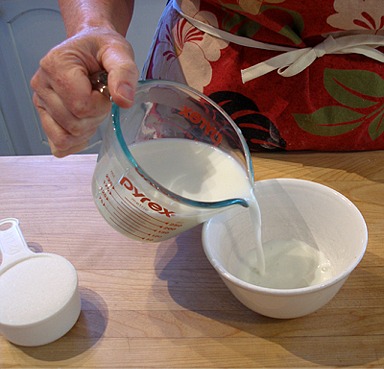
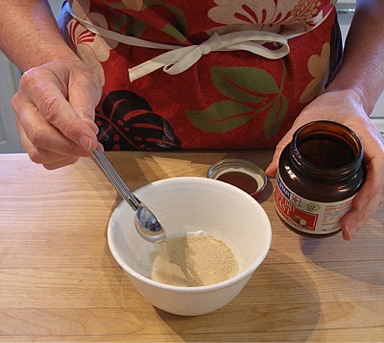
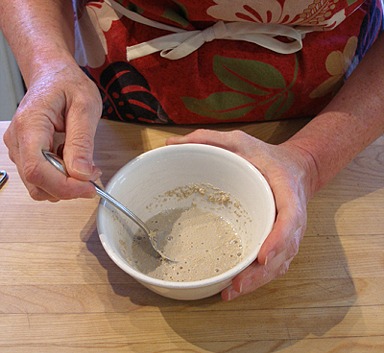
Mix the initial bread dough:
1. Place yeast mixture, the remaining 1/4 cup milk, 1/2 cup sugar, melted butter, eggs, vanilla, and salt to the bowl of a stand mixer, with paddle attachment in place, and stir to combine.
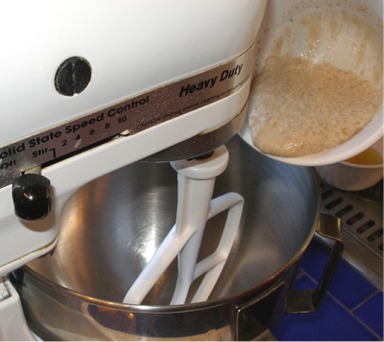
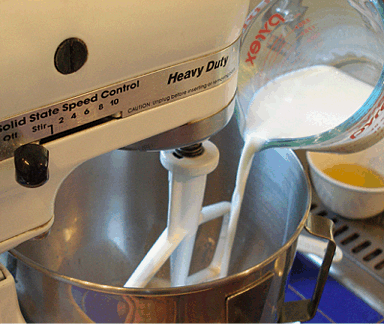
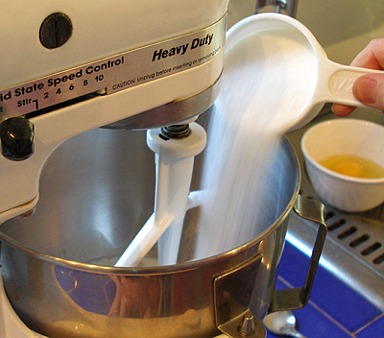
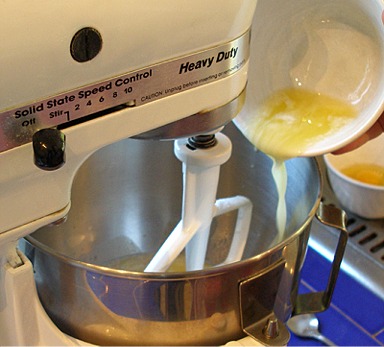
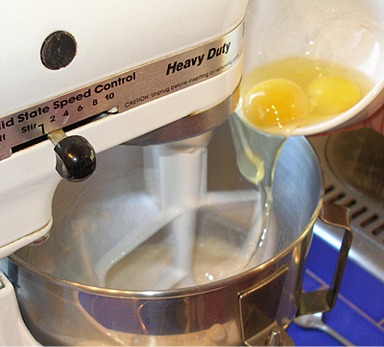
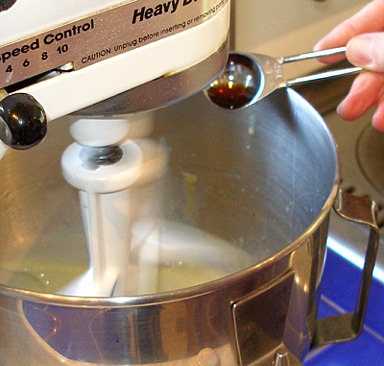
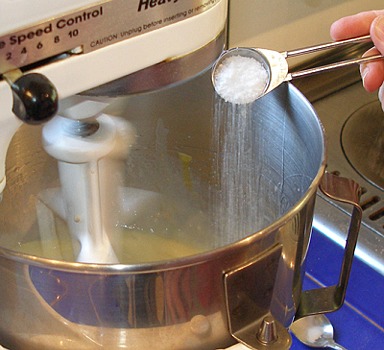
2. With the mixer on low, slowly add in 3 cups of the flour and mix till smooth.
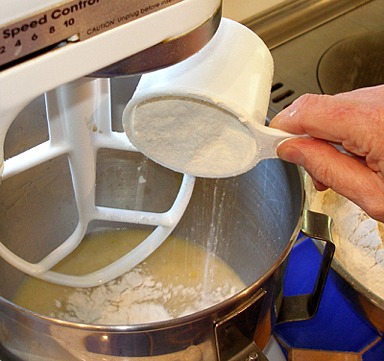
3. Add raisins and mix till combined. If raisins are stuck together, break them up with your hand, while adding them to the bowl.
Make sure they are not dry.
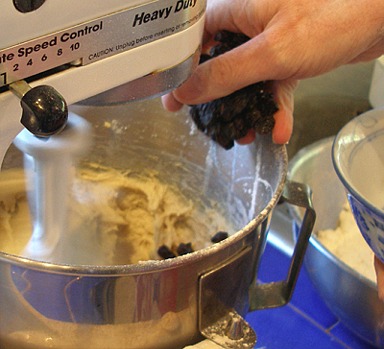
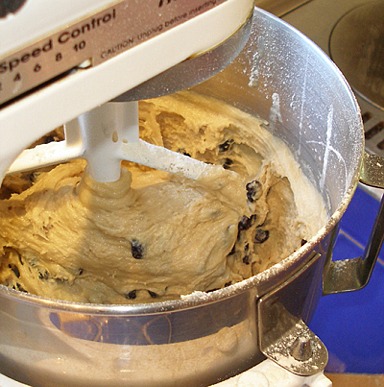
4. Change the mixer to the dough hook attachment and add one more cup of flour.
Mix at medium speed, for three minutes.
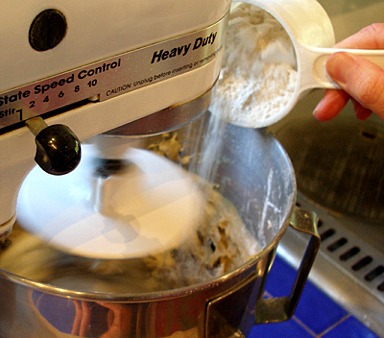
5. Add more flour, a little bit at a time, till a soft dough, that starts to pull away from the sides of the mixing bowl, is formed.
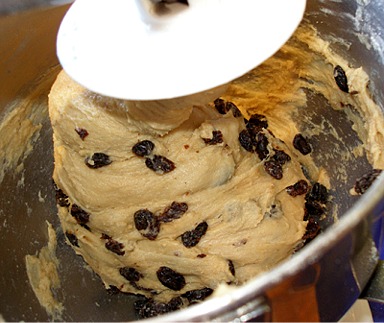
6. Remove dough from bowl onto a lightly floured surface. Do not pull at it while you do.
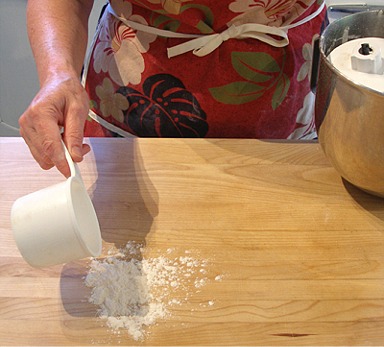
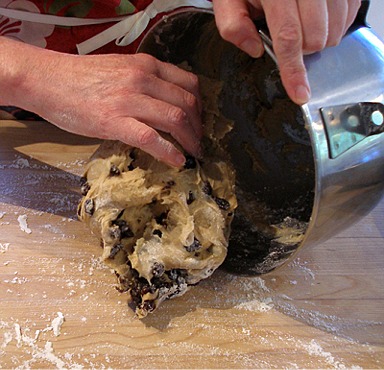
STEP II: KNEAD THE BREAD DOUGH
1. Knead dough for a few minutes, by hand, till it is smooth and elastic.
If dough is sticky, add a little more flour, to keep it from sticking to your hands. The dough should still be soft.
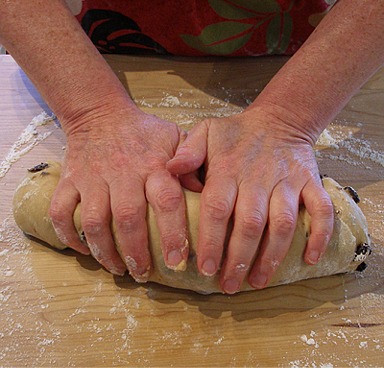
2. Afterwards, form the dough into a tight ball called rounding.
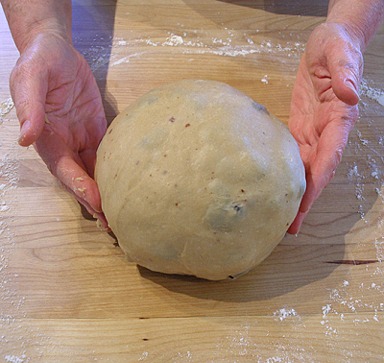
STEP III: LET THE DOUGH RISE AND MAKE THE CINNAMON FILLING
1. Put the dough ball in a lightly oiled bowl, turning it over, so all of it is lightly coated.
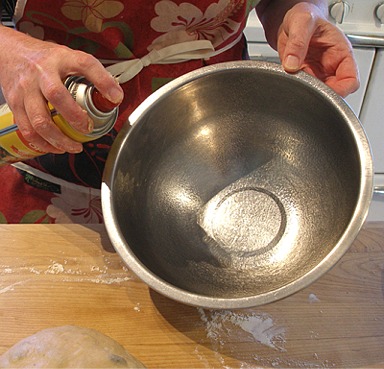
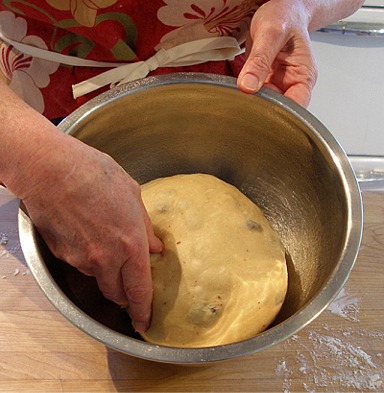
2. Cover bowl tightly with plastic wrap and set it aside, in a warm place, to rise, till ALMOST doubled. This will take 1- 1 1/2 hours, depending on the temperature of the room.
You may also use Sarah's Microwave Bread Proofer, to speed up the process.
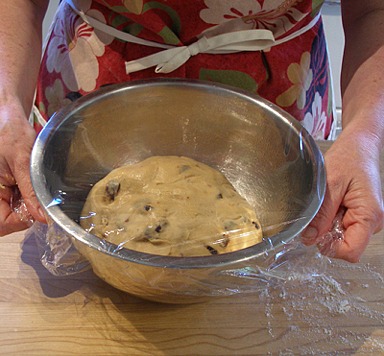
3. Meanwhile, grease two loaf pans and set aside.
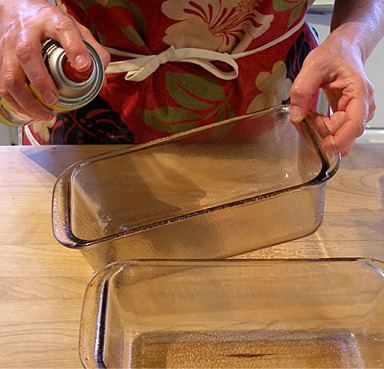
Meanwhile make the cinnamon filling:
1. Mix the sugar, cinnamon and melted, but cooled butter together in a small bowl, to make a paste. Cover with plastic wrap and set aside.
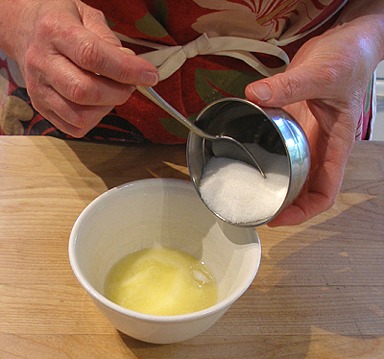
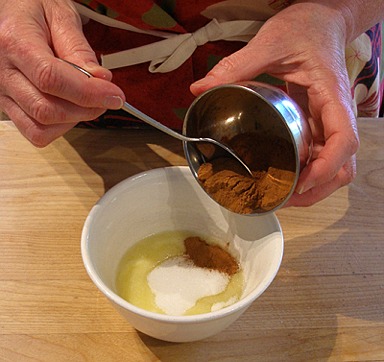
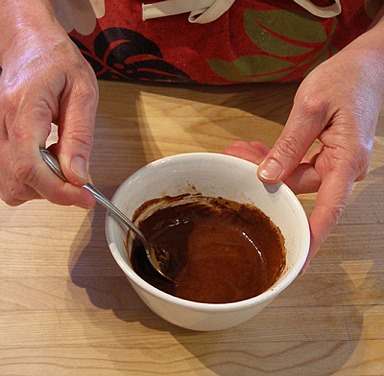
STEP IV: TURN THE RISEN DOUGH FROM ITS BOWL, FILL WITH THE CINNAMON FILLING AND ROLL
Turn the dough from its bowl:
1. When the dough has ALMOST doubled in size, without first pressing on the risen dough to deflate it, gently turn it as is from its bowl on a lightly floured surface.
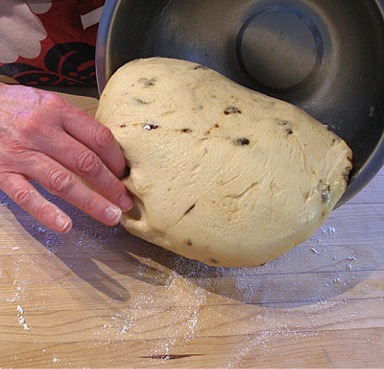
Divide the dough:
2. Cut the dough in half pressing straight down with a bench scraper or sharp knife. Do NOT pull on it.
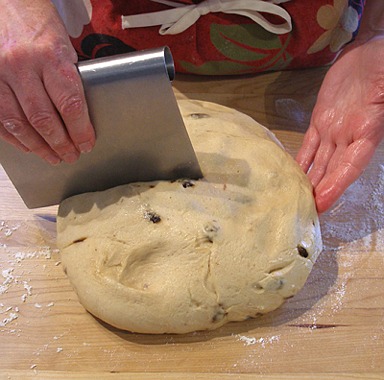
Place one 1/2 under the bowl, while you work with the other half.
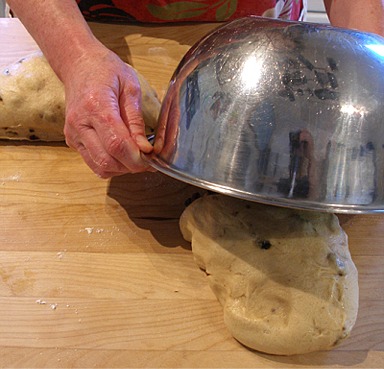
Shape and fill the dough:
3. Gently press the dough into a rough rectangle, then roll the dough out to measure approximately 9- X 12-inches.
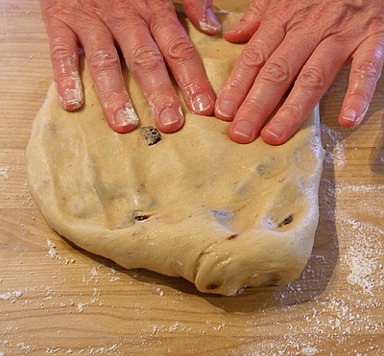
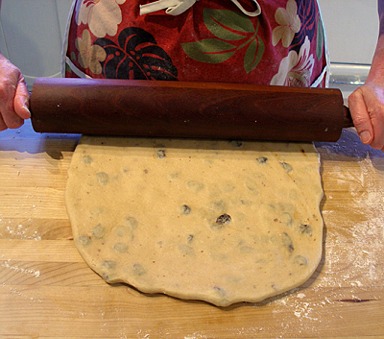
4. Place 1/2 of the sugar/cinnamon/butter mixture on the dough and spread it evenly over the bread.
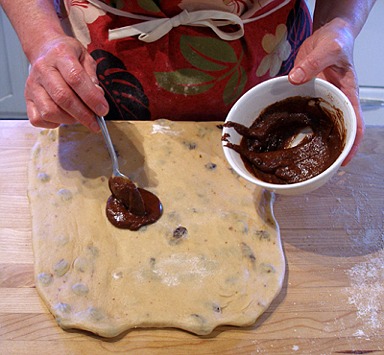
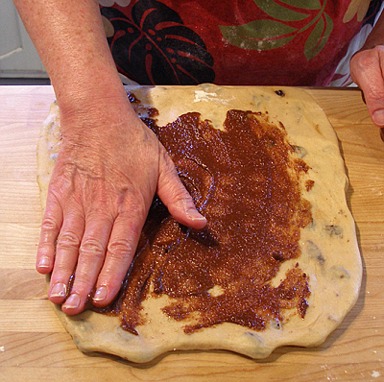
Roll the dough:
5. Roll dough, starting at the short side, into a tight cylinder.
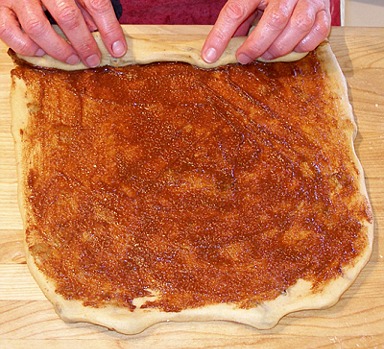
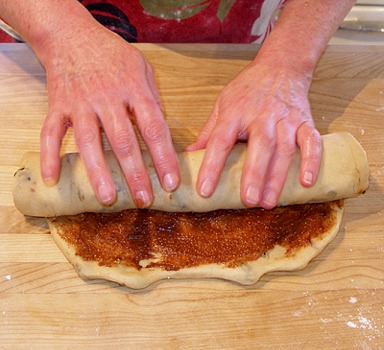
6. Pinch the seam together.
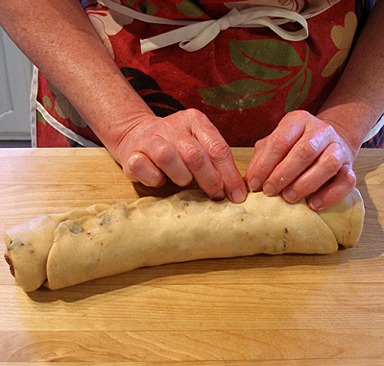
7. Tuck the ends of the roll under, to neaten, and then place the dough, seam side down, in the greased loaf pan.
Cover pan tightly with plastic wrap.
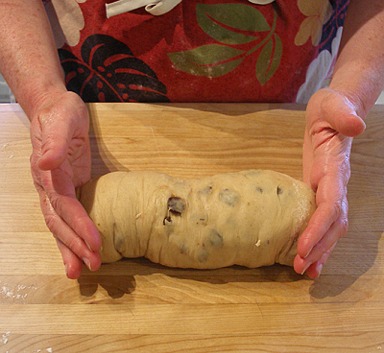
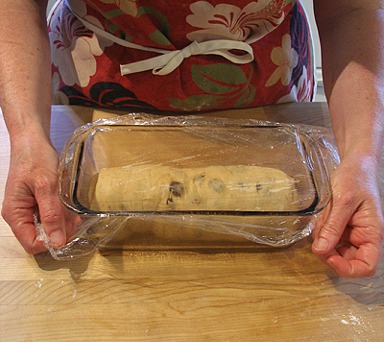
8. Then, repeat the filling process, Steps 3 – 7, above, with the other 1/2 of the dough.
STEP V: LET THE LOAVES RISE, PREHEAT THE OVEN AND BAKE
Let loaves rise:
1. Set loaves aside for 1 – 1 1/2 hours, or till loaves are doubled and the centers of the loaves come just to the top of the loaf pans.
You may also use Sarah's Microwave Bread Proofer, t speed up the process.
NOTE: The loaves will expand more in the oven, called oven spring. You do not want to over-proof the dough, or the spiral may not stay tight inside the loaves.
2. About 30 minutes before baking, position an oven shelf in the middle of the oven and preheat oven to 375 degrees F.
NOTE: Do NOT reduce the oven heat by 25 degrees F when using glass or dark metal baking pans.
3. When loaves have almost doubled, brush the tops of the loaves with melted butter.
Place in the preheated oven, and immediately turn oven down to 350 degrees F.
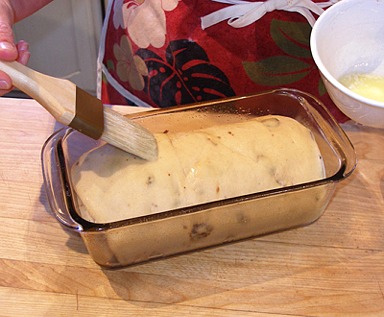
Bake and Cool:
1. Bake loaves for 20 minutes, then cover each loaf with aluminum foil so the tops do not brown too much.
Then, bake for an additional 20-25 minutes, or until the bread is golden brown and sounds hollow when the bottom of the loaf is tapped.
NOTE: Another way to check for doneness is: insert the thermometer through the bottom of the loaf to its middle to measure the bread's internal temperature; if it's between 190 and 210 degrees F, it is done.
Make sure you are not testing the cinnamon sugar part of the loaf, which will be very hot.
If not, place the loaf back in the pan and return it to the oven. Check it again in 5 to 10 minutes.
2. Place pans on a cooling rack for 5 minutes, then unmold loaves and let them cool, on their sides, on the rack.
STORAGE
Wait until the bread cools completely before wrapping the loaf in plastic wrap or a few times in foil and storing it in an airtight plastic bag or in a bread box.
Bread is best stored at room temperature in a cool, dry place for 2 to 3 days or kept frozen, where it will keep fresh for 2 to 3 months.
Pre-slice it, if you want to, so you can take out one or two slices at a time.



